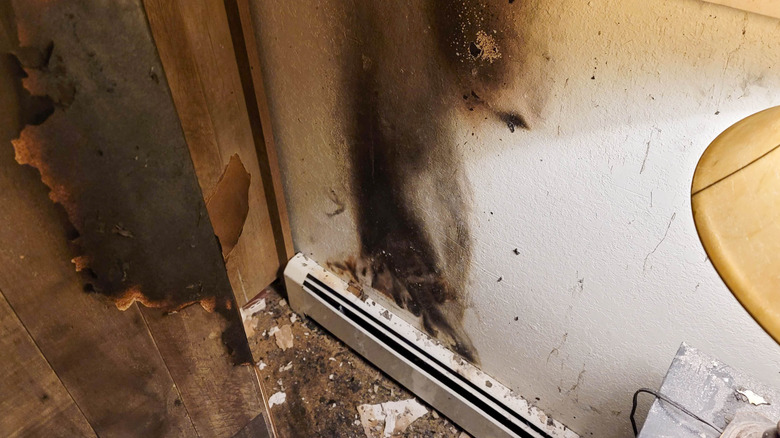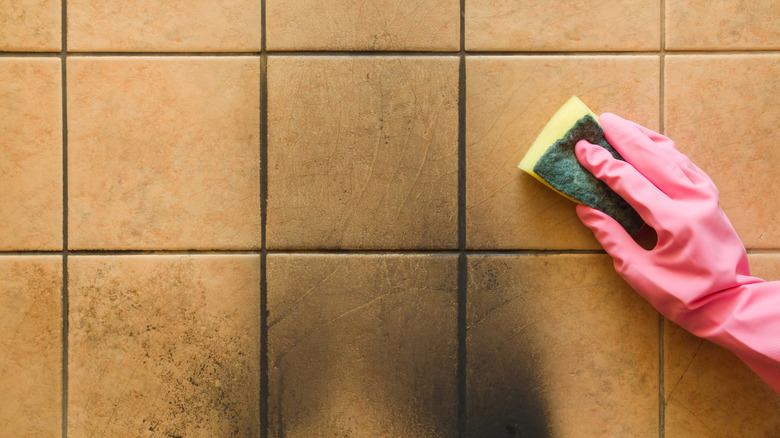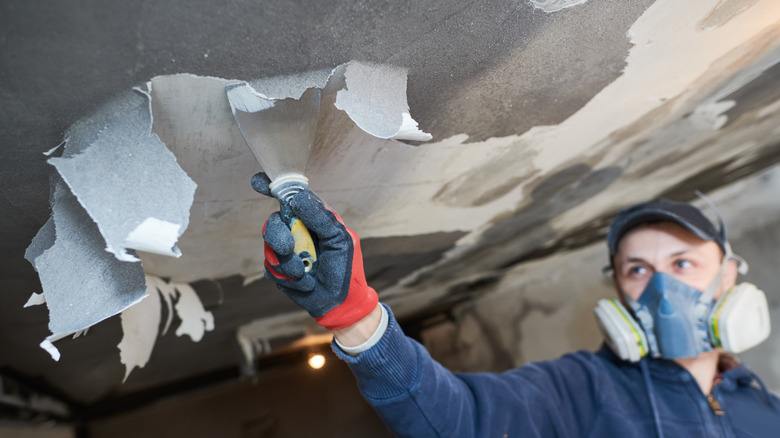Tips For Cleaning And Removing Soot From Walls After A Fire
No matter their size, house fires are an incredibly frightening thing to experience. The turmoil doesn't end when the flames are put out, either. Returning home after a fire is exhausting, considering the mess you need to clean up after. While a severe fire may require calling in professionals for help, you can tackle basics like removing soot from your walls with a mild soap, degreaser, and some bleach.
Soot forms during a fire as a by-product of incomplete burning. It comprises a mixture of elements found in your home, including wood, plastics, and building materials. Since soot is often sticky, it can cling onto any surface in your home. Beyond your walls, you may discover soot on your ceiling, furniture, and other items. Although soot is most often pictured as black, it can also be dark brown in color. Sometimes, soot may appear as a greasy residue that will deeply penetrate porous materials like fabric or wood furniture — these scenarios require special cleaning products.
Before you begin cleaning soot from your home's walls, you must tackle some preparation tasks, like removing or covering any furniture and floors. Doing so will spare them from further damage if any soot falls while you're cleaning. Then ventilate the space to avoid breathing in particles once you get to work. This is important, because soot exposure may cause coughing, difficulty breathing, irritated eyes, nosebleeds, asthma attacks, and other ailments. Worse, soot may contain carcinogens like arsenic, cadmium, and chromium. To ventilate an area, you can open windows and run fans. However, do not use your air conditioner or HVAC system, as the ducts are likely full of soot.
Steps for wiping soot off walls
Before you start cleaning, put on personal protective equipment, including goggles, a face mask, and clothes that shield your body from soot particles. Breathing soot in isn't the only risk; the particles are also small enough to enter your body through your skin and eyes. When choosing a mask, don't pick up the first one you see at the store. Instead, use a high filtration efficiency respirator, like the N95.
To tackle soot on walls, start by gently wiping them with a dry soot sponge. If you have a vacuum with a HEPA filter, you can also use it to remove visible soot. Once that's done, mix mild soap with water, or add 5 tablespoons of trisodium phosphate (a powerful degreaser) and a cup of bleach to a gallon of warm water to create the cleaning solution. Then, apply the mixture to your walls with a sponge or soft cloth. Wipe one small area at a time and work from the floor up to reduce streaks. When you're done, rinse the wall surface with clear water.
After you've finished with your initial clean, your walls are at risk of growing mold or mildew. You can reduce this by wiping them down with a mixture of a cup of bleach to a gallon of water. Before treating the entire area with the bleach solution, apply the mixture to a small patch and wait 24 hours to ensure that it won't discolor the surface. While you wait on that test, dry the rest of your walls completely, then dry them again after the solution is applied.
Other tips for cleaning your home after a fire
Once you've removed soot from your walls, you will likely need to re-paint them. To do so, you will need a primer specifically designed for smoke and fire damage. In addition, you want to choose stain-blocking paints, as they can help reduce the chances of any lingering residue seeping through. Keep in mind that you might need to apply more coats of paint than normal for optimal results. While it is possible to DIY this aspect of restoration, you may also want to consult a professional to ensure that you have adequately cleaned your walls first.
Beyond walls, there may still be a lot of damage in your home to deal with. However, we have you covered if you need more advice on the best way to clean up after a house fire. One of the most annoying things to deal with, though, is the residual smell after a fire. If you find yourself struggling, you can also follow these tips to get rid of that smoke smell by deodorizing your floors, baseboards, and more. To avoid any future accidents, it is also important to remain aware of fire risks in your home. In the United States, cooking is one of the most common causes of house fires, so you must mitigate the hazard in the kitchen. Some kitchen ingredients that can pose a fire risk include the obvious cooking oils but also some not-so-obvious items, like certain snacks and spices.


